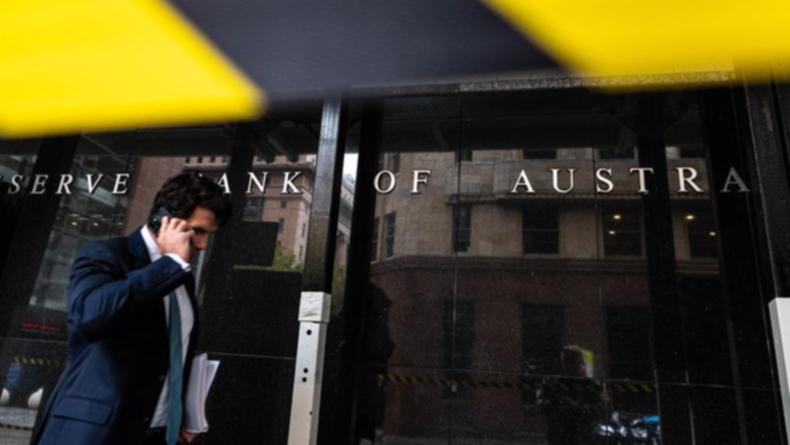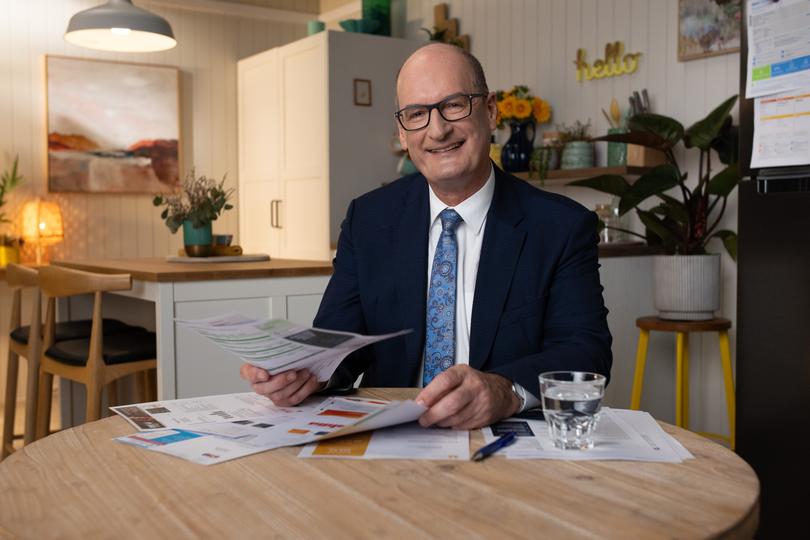RBA interest rates recap: Reserve holds at April meeting as it awaits election, tariffs fallout

The Reserve Bank’s first meeting after providing long-awaited interest rate relief to millions of homeowners just had to fall on April Fools Day, didn’t it?
Under the cover of lighthearted frivolity, we could easily spin you some wildly outrageous yarn about the bank repossessing RBA governor Michele Bullock’s home or the entire RBA board quitting en masse to start their own Dire Straits cover band (Money for Nothing, anyone?)
But, as we’ve learnt the hard way over the past few years, joking about the perilous state of people’s finances and the economy in general is about as cringeworthy as a Meghan Markle cooking show.
Also, in these crazy times when it seems that anything - no matter how absurd - is now possible, it’s getting harder to separate fiction from the holy-crap-did that-really-just-happen facts.
Yes, as Dylan told us: Times, they are a changin’.
But one thing that certainty wasn’t shifting today was the official cash rate, which dropped to 4.1 per cent at the last RBA meeting in mid-February.
Why? Well, there’s a Federal election around the corner and the central bank board will be very happy to keep its powder dry and well away from any suggestion of playing politics, particularly when the campaigns are so focused on the cost of living burden.
But, more importantly, the case for more relief is still pretty flimsy.
Most market punters agree there’s a few more cuts to come this year, but we’ll likely have to wait until at least May for the next one.
Inflation is still moderating, and is within the RBA’s preferred 2 to 3 per cent target band, but the board is likely to want to see a broader set of numbers before cutting again.
Then there’s the Trump card. The US President is preparing to unveiling sweeping global tariffs tomorrow. While Australia may yet avoid a direct hit, the ramifications for the world’s biggest economies could be substantial and send plenty of aftershocks our way.
The RBA wants to hold fire for now until it has a better idea of what lies ahead.
For those who did bet on a cut may have done well to recall the adage “a fool and his money are soon parted”.
Sorry.
Key events
01 Apr 2025 - 12:49 PM
No mention of the election
01 Apr 2025 - 12:14 PM
More clarity to come
01 Apr 2025 - 12:03 PM
And each-way bet?
01 Apr 2025 - 11:48 AM
Too many unknowns to make a change
01 Apr 2025 - 11:45 AM
On the jobs market ...
01 Apr 2025 - 11:36 AM
In the RBA’s words ...
01 Apr 2025 - 11:32 AM
No-go on a second round of cuts
01 Apr 2025 - 11:17 AM
We’re just 15 minutes away ...
01 Apr 2025 - 11:07 AM
PM asked about looming RBA decision
01 Apr 2025 - 10:50 AM
The current economy, by the numbers ...
01 Apr 2025 - 10:39 AM
How to make sure your super survives Trump’s tariff war
01 Apr 2025 - 10:35 AM
Countdown is on ...
01 Apr 2025 - 10:23 AM
How a rate cut boosts the economy
01 Apr 2025 - 09:52 AM
House prices back in record territory after last rate cut
01 Apr 2025 - 09:29 AM
Golden run continues for safe haven metal
01 Apr 2025 - 09:17 AM
Treasurer backs in market’s bet on no cut
01 Apr 2025 - 09:01 AM
How much interest do you pay a day?
01 Apr 2025 - 08:48 AM
Retail sales hold steady
01 Apr 2025 - 08:40 AM
What is ‘Liberation Day’?
No mention of the election
Michele Bullock told reporters the Federal election did not factor into her thinking and was never mentioned during the two days of the board’s deliberations.
“The focus very is much on the data, the information, what we think is best for trying to get inflation back down to levels and the political cycle - we’ve just got to remain coompletely removed from,” she said at the post-rates call briefing.
Economy prepared for global shockwaves, says Bullock
Despite the unheaval across global markets since its February meeting, the RBA says the domestic economic has continued “broadly” as expected.
With inflation coming down and low unemployment, governor Michele Bullock has told reporters Australia is well positioned “for any shocks that might come our way”.
More clarity to come
RBA boss Michele Buillock will front the media in about 15 minutes.
Expect plenty of questions about the economic impact to Australia of Trump’s looming tariffs.
And each-way bet?
That’s how Pradeep Philip, head of Deloitte Access Economics, is seeing the RBA decision to keep rates at 4.1 per cent.
Mr Philip said the board clearly sees the next move in inflation as an “each-way bet”.
“Australians may be disappointed in that decision, but they should not be surprised,” he said.
“February’s rate cut was a cautious one, made with one eye on the various upside risks to inflation: a tight labour market, considerable geopolitical uncertainty around tariffs, and low productivity growth.
“Two months on, and these factors are still in play, and are clearly being closely watched by the RBA’s new-look monetary policy board.”
But Mr Philip said the case for a second rate cut was growing as the labour market showing signs of weakness following a sharp drop in employment in February.
“And of course, February consumer price index data showed monthly underlying inflation falling to its lowest levels in more than three years,” he said.
“The RBA will wait for March quarter inflation data before considering pulling the rate cut trigger, but will find the clear easing in rent and building costs identifiable in the monthly data encouraging.”
Too many unknowns to make a change
Compare the Market’s David Koch says while a pre-election rate cut would have returned about $1200 to average homeowners each year, the Reserve was never likely to make a move lower.
“Remember, financial markets and central bankers hate uncertainty and there’s a lot of that right now in the United States,” Mr Koch said.
“Virtually every day we wake up and Trump has announced new tariffs or sanctions. I think the Reserve Bank’s going to be really cautious because tariffs push prices up, and that feeds inflation.
“Meanwhile, there are concerns that America’s economy could be pushed into a recession. The cycle might be starting again. We could even see rates go up, rather than down, depending on what happens in the next 12 months.”

But Mr Koch said homeowners could still try to negotiate their own rate cuts with their bank or mortgage broker.
“We can’t rely on the Reserve Bank to deliver mortgage relief. That means we have to be more vigilant ourselves to make sure we’re getting a good deal,” Mr Koch said.
“Homeowners who have been with the same lender for a number of years need to make sure they are at a rate that is commensurate with what new customers are getting.”
On the jobs market ...
The central bank’s board says a range of indicators suggest that labour market conditions remain tight.
“Despite a decline in employment in February, measures of labour underutilisation are at relatively low rates and business surveys and liaison suggest that availability of labour is still a constraint for a range of employers,” it said.
“Wage pressures have eased a little more than expected but productivity growth has not picked up and growth in unit labour costs remains high.”
In the RBA’s words ...
This statement, released just minutes ago, speaks volumes about the possible headwinds the central bank is preparing for in the months ahead ...
“Uncertainty about the outlook abroad also remains significant,” it said.
“On the macroeconomic policy front, recent announcements from the United States on tariffs are having an impact on confidence globally and this would likely be amplified if the scope of tariffs widens, or other countries take retaliatory measures.
“Geopolitical uncertainties are also pronounced. These developments are expected to have an adverse effect on global activity, particularly if households and firms delay expenditures pending greater clarity on the outlook.
“Inflation, however, could move in either direction. Many central banks have eased monetary policy since the start of the year, but they have become increasingly attentive to the evolving risks from recent global policy developments.”
No-go on a second round of cuts
As expected, the RBA has held fire on a second-consecutive cut, saying monetary policy was well placed to respond to international developments if they were to have material implications for Australian activity and inflation.
We’re just 15 minutes away ...
We may have enjoyed one cut but don’t start popping champagne corks in anticipation of another ... yet.
By cutting in February, and delivering strong guidance not to expect another near-term cut, the RBA has largely taken itself out of the national economic discussion as the electoral process plays out.
That’s the view of HSBC chief economist Paul Bloxham, who expects the board to deprive the Opposition of ammunition to launch another political broadside.
PM asked about looming RBA decision
Asked about the Reserve Bank board’s rates decision due this afternoon, Anthony Albanese lauds the hard work of Australians in getting inflation down.
The RBA is widely expected to keep rates on hold rather than cut for the second time in a row.
“We have worked very hard with the Australian people, Australians have worked hard to get those inflation rates down,” Mr Albanese says, noting that CPI is now less than half what it was when Labor came into office.
“Our task is to continue to get inflation down further, to continue to maintain strong employment, but also importantly, to continue to have people earn more and to keep more of what they earn.”
He doesn’t speculate on what the RBA might do.

